Experimental Study on Cooling Performance of a Hybrid Microchannel and Jet Impingement Heat Sink
Abstract
1. Introduction
2. Experimental Apparatus
2.1. Experimental System
2.2. Test Section
2.3. Measurement of Thermal Interfacial Resistance
3. Data Reduction and Uncertainty Analysis
4. Results and Discussion
4.1. Calculation of Thermal Resistances of an AlN Substrate and Silicone Grease
4.2. Cooling Performance of the Hybrid Microchannel Heat Sink
5. Conclusions
Author Contributions
Funding
Institutional Review Board Statement
Informed Consent Statement
Data Availability Statement
Conflicts of Interest
Nomenclature
| A | area (m2) | h | heat sink |
| h | fluid enthalpy (kJ/kg) | hw | heating wire |
| I | current (A) | i | number |
| m | mass flow rate (kg/s) | in | inlet |
| P | pressure (MPa) | iw | inside wall |
| Q | input power (W) | lv | latent heat of vaporization |
| q | heat flux (W/m2) | out | outlet |
| Re | electric resistance (Ω) | ow | outside wall |
| Rth | thermal resistance (K/W) | sat | saturation |
| T | temperature (K) | th | thermal |
| U | voltage (V) | w | wall |
| x | vapor quality | Abbreviations | |
| Greek symbols | AlN | aluminum nitride | |
| λ | thermal conductivity (W·m−1·K−1) | CHF | critical heat flux |
| Subscripts | WCu | tungsten copper | |
| e | electric | ||
References
- Liu, X.; Zhao, W.; Xiong, L.; Liu, H. (Eds.) Packaging Process of High Power Semiconductor Lasers. In Packaging of High Power Semiconductor Lasers; Springer: New York, NY, USA, 2015; pp. 185–226. [Google Scholar]
- Mudawar, I. Two-Phase Microchannel Heat Sinks: Theory, Applications, and Limitations. J. Electron. Packag. 2011, 133, 041002. [Google Scholar] [CrossRef]
- Sourtiji, E.; Peles, Y. Flow boiling in microchannel with synthetic jet in cross-flow. Int. J. Heat Mass Transf. 2020, 147, 119023. [Google Scholar] [CrossRef]
- Tuckerman, D.B.; Pease, R.F.W. High-performance heat sinking for VLSI. IEEE Electron Device Lett. 1981, 2, 126–129. [Google Scholar] [CrossRef]
- Kreutz, E.W.; Pirch, N.; Ebert, T.; Wester, R.; Ollier, B.; Loosen, P.; Poprawe, R. Simulation of micro-channel heat sinks for optoelectronic microsystems. Microelectron. J. 2000, 31, 787–790. [Google Scholar] [CrossRef]
- Kandlikar, S.G. History, Advances, and Challenges in Liquid Flow and Flow Boiling Heat Transfer in Microchannels: A Critical Review. J. Heat Transf. 2012, 134, 034001. [Google Scholar] [CrossRef]
- Prajapati, Y.K.; Bhandari, P. Flow boiling instabilities in microchannels and their promising solutions—A review. Exp. Therm. Fluid Sci. 2017, 88, 576–593. [Google Scholar] [CrossRef]
- Muwanga, R.; Hassan, I.; MacDonald, R. Characteristics of Flow Boiling Oscillations in Silicon Microchannel Heat Sinks. J. Heat Transf. 2007, 129, 1341–1351. [Google Scholar] [CrossRef]
- Zhang, T.; Peles, Y.; Wen, J.T.; Tong, T.; Chang, J.-Y.; Prasher, R.; Jensen, M.K. Analysis and active control of pressure-drop flow instabilities in boiling microchannel systems. Int. J. Heat Mass Transf. 2010, 53, 2347–2360. [Google Scholar] [CrossRef]
- Oudah, S.K.; Fang, R.; Tikadar, A.; Salman, A.S.; Khan, J.A. An experimental investigation of the effect of multiple inlet restrictors on the heat transfer and pressure drop in a flow boiling microchannel heat sink. Int. J. Heat Mass Transf. 2020, 153, 119582. [Google Scholar] [CrossRef]
- Kozłowska, A.; Łapka, P.; Seredyński, M.; Teodorczyk, M.; Dąbrowska-Tumańska, E. Experimental study and numerical modeling of micro-channel cooler with micro-pipes for high-power diode laser arrays. Appl. Therm. Eng. 2015, 91, 279–287. [Google Scholar] [CrossRef]
- Drummond, K.P.; Back, D.; Sinanis, M.D.; Janes, D.B.; Peroulis, D.; Weibel, J.A.; Garimella, S.V. A hierarchical manifold microchannel heat sink array for high-heat-flux two-phase cooling of electronics. Int. J. Heat Mass Transf. 2018, 117, 319–330. [Google Scholar] [CrossRef]
- Jia, G.; Qiu, Y.; Yan, A.; Yao, S.; Wang, Z. Laser three-dimensional printing microchannel heat sink for high-power diode laser array. Opt. Eng. 2016, 55, 096105. [Google Scholar] [CrossRef]
- Deng, Z.; Shen, J.; Dai, W.; Li, K.; Song, Q.; Gong, W.; Dong, X.; Gong, M. Experimental study on cooling of high-power laser diode arrays using hybrid microchannel and slot jet array heat sink. Appl. Therm. Eng. 2019, 162, 114242. [Google Scholar] [CrossRef]
- Farsad, E.; Abbasi, S.P.; Zabihi, M.S. Fluid Flow and Heat Transfer in a Novel Microchannel Heat Sink Partially Filled With Metal Foam Medium. J. Therm. Sci. Eng. Appl. 2014, 6, 021011. [Google Scholar] [CrossRef]
- Baraty Beni, S.; Bahrami, A.; Salimpour, M.R. Design of novel geometries for microchannel heat sinks used for cooling diode lasers. Int. J. Heat Mass Transf. 2017, 112, 689–698. [Google Scholar] [CrossRef]
- Kim, C.-B.; Leng, C.; Wang, X.-D.; Wang, T.-H.; Yan, W.-M. Effects of slot-jet length on the cooling performance of hybrid microchannel/slot-jet module. Int. J. Heat Mass Transf. 2015, 89, 838–845. [Google Scholar] [CrossRef]
- Robinson, A.J.; Kempers, R.; Colenbrander, J.; Bushnell, N.; Chen, R. A single phase hybrid micro heat sink using impinging micro-jet arrays and microchannels. Appl. Therm. Eng. 2018, 136, 408–418. [Google Scholar] [CrossRef]
- Li, X.-Y.; Wang, S.-L.; Wang, X.-D.; Wang, T.-H. Selected porous-ribs design for performance improvement in double-layered microchannel heat sinks. Int. J. Therm. Sci. 2019, 137, 616–626. [Google Scholar] [CrossRef]
- Wang, S.-L.; Chen, L.-Y.; Zhang, B.-X.; Yang, Y.-R.; Wang, X.-D. A new design of double-layered microchannel heat sinks with wavy microchannels and porous-ribs. J. Therm. Anal. Calorim. 2020, 141, 547–558. [Google Scholar] [CrossRef]
- Zhou, F.; Zhou, W.; Zhang, C.; Qiu, Q.; Yuan, D.; Chu, X. Experimental and numerical studies on heat transfer enhancement of microchannel heat exchanger embedded with different shape micropillars. Appl. Therm. Eng. 2020, 175, 115296. [Google Scholar] [CrossRef]
- Woodcock, C.; Ng’oma, C.; Sweet, M.; Wang, Y.; Peles, Y.; Plawsky, J. Ultra-high heat flux dissipation with Piranha Pin Fins. Int. J. Heat Mass Transf. 2019, 128, 504–515. [Google Scholar] [CrossRef]
- Liao, W.-R.; Chien, L.-H.; Ghalambaz, M.; Yan, W.-M. Experimental study of boiling heat transfer in a microchannel with nucleated-shape columnar micro-pin-fins. Int. Commun. Heat Mass Transf. 2019, 108, 104277. [Google Scholar] [CrossRef]
- Cheng, X.; Wu, H. Improved flow boiling performance in high-aspect-ratio interconnected microchannels. Int. J. Heat Mass Transf. 2021, 165, 120627. [Google Scholar] [CrossRef]
- Deng, D.; Xie, Y.; Huang, Q.; Wan, W. On the flow boiling enhancement in interconnected reentrant microchannels. Int. J. Heat Mass Transf. 2017, 108, 453–467. [Google Scholar] [CrossRef]
- Deng, D.; Chen, L.; Wan, W.; Fu, T.; Huang, X. Flow boiling performance in pin fin- interconnected reentrant microchannels heat sink in different operational conditions. Appl. Therm. Eng. 2019, 150, 1260–1272. [Google Scholar] [CrossRef]
- Li, W.; Ma, J.; Alam, T.; Yang, F.; Khan, J.; Li, C. Flow boiling of HFE-7100 in silicon microchannels integrated with multiple micro-nozzles and reentry micro-cavities. Int. J. Heat Mass Transf. 2018, 123, 354–366. [Google Scholar] [CrossRef]
- Zhou, J.; Luo, X.; Pan, Y.; Wang, D.; Xiao, J.; Zhang, J.; He, B. Flow boiling heat transfer coefficient and pressure drop in minichannels with artificial activation cavities by direct metal laser sintering. Appl. Therm. Eng. 2019, 160, 113837. [Google Scholar] [CrossRef]
- Cheng, X.; Wu, H. Experimental Comparison of Flow Boiling Heat Transfer in High Aspect Ratio Microchannels With Plain and Grooved Walls. J. Heat Transf. 2020, 142, 121602. [Google Scholar] [CrossRef]
- He, B.; Luo, X.; Yu, F.; Zhou, J.; Zhang, J. Flow boiling characteristics in bi-porous minichannel heat sink sintered with copper woven tape. Int. J. Heat Mass Transf. 2020, 158, 119988. [Google Scholar] [CrossRef]
- Li, H.-W.; Zhang, C.-Z.; Yang, D.; Sun, B.; Hong, W.-P. Experimental investigation on flow boiling heat transfer characteristics of R141b refrigerant in parallel small channels filled with metal foam. Int. J. Heat Mass Transf. 2019, 133, 21–35. [Google Scholar] [CrossRef]
- Zhang, S.; Sun, Y.; Yuan, W.; Tang, Y.; Tang, H.; Tang, K. Effects of heat flux, mass flux and channel width on flow boiling performance of porous interconnected microchannel nets. Exp. Therm. Fluid Sci. 2018, 90, 310–318. [Google Scholar] [CrossRef]
- Li, W.; Yang, F.; Qu, X.; Li, C. Wicking Nanofence-Activated Boundary Layer to Enhance Two-Phase Transport in Microchannels. Langmuir 2020, 36, 15536–15542. [Google Scholar] [CrossRef] [PubMed]
- Kousalya, A.S.; Singh, K.P.; Fisher, T.S. Heterogeneous wetting surfaces with graphitic petal-decorated carbon nanotubes for enhanced flow boiling. Int. J. Heat Mass Transf. 2015, 87, 380–389. [Google Scholar] [CrossRef]
- Ghosh, D.P.; Sharma, D.; Mohanty, D.; Saha, S.K.; Raj, R. Facile Fabrication of Nanostructured Microchannels for Flow Boiling Heat Transfer Enhancement. Heat Transf. Eng. 2019, 40, 537–548. [Google Scholar] [CrossRef]
- Ma, L.; Zhao, X.; Sun, H.; Wu, Q.; Liu, W. Experimental Study of Single Phase Flow in a Closed-Loop Cooling System with Integrated Mini-Channel Heat Sink. Entropy 2016, 18, 128. [Google Scholar] [CrossRef]
- Dix, J.; Jokar, A. Fluid and thermal analysis of a microchannel electronics cooler using computational fluid dynamics. Appl. Therm. Eng. 2010, 30, 948–961. [Google Scholar] [CrossRef]
- Farsad, E.; Abbasi, S.P.; Zabihi, M.S.; Sabbaghzadeh, J. Numerical simulation of heat transfer in a micro channel heat sinks using nanofluids. Heat Mass Transf. 2011, 47, 479–490. [Google Scholar] [CrossRef]
- Deng, Z.; Shen, J.; Gong, W.; Dai, W.; Gong, M. Temperature distribution and thermal resistance analysis of high-power laser diode arrays. Int. J. Heat Mass Transf. 2019, 134, 41–50. [Google Scholar] [CrossRef]
- Browne, E.A.; Michna, G.J.; Jensen, M.K.; Peles, Y. Experimental Investigation of Single-Phase Microjet Array Heat Transfer. J. Heat Transf. 2010, 132, 041013. [Google Scholar] [CrossRef]
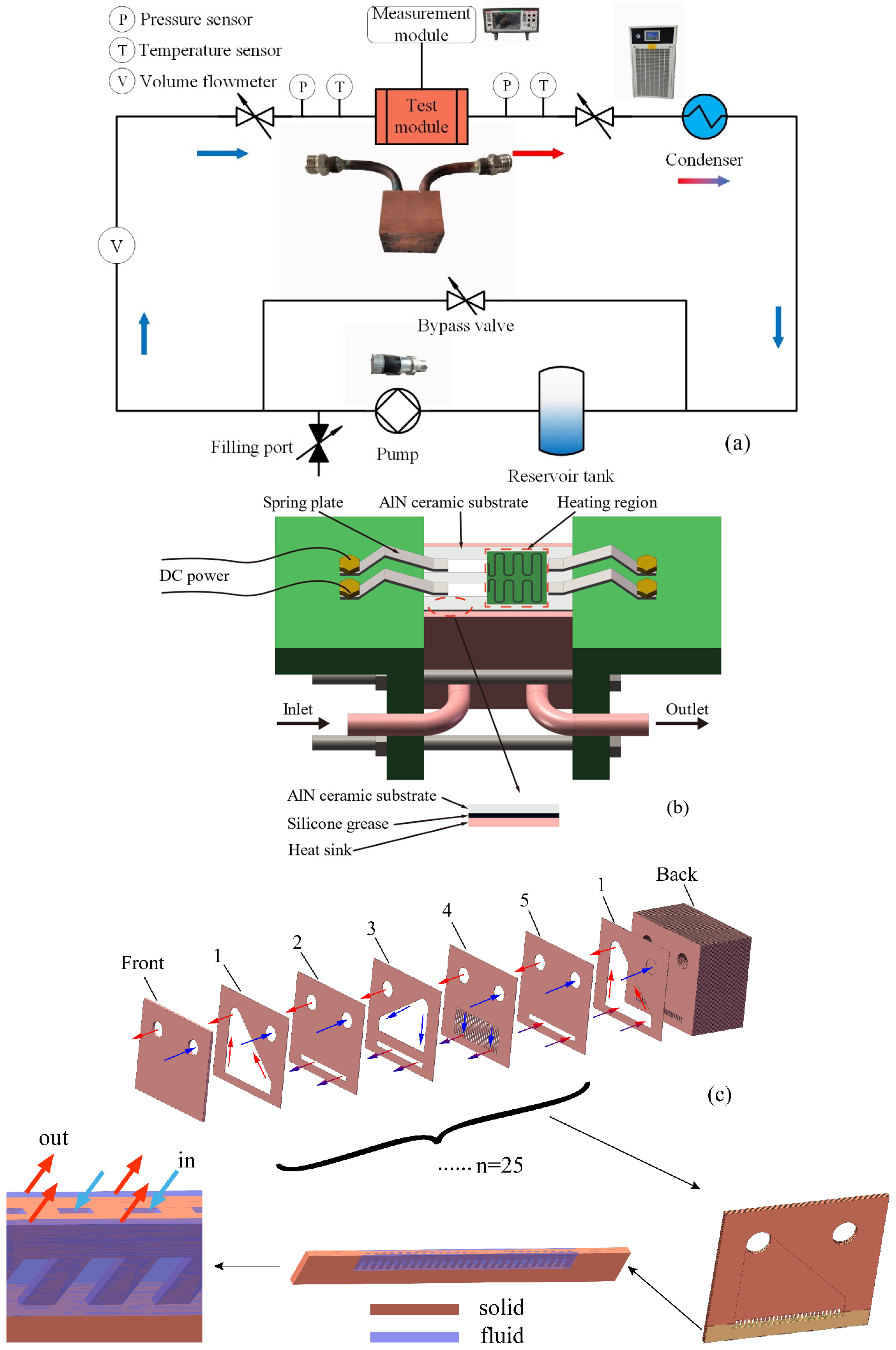



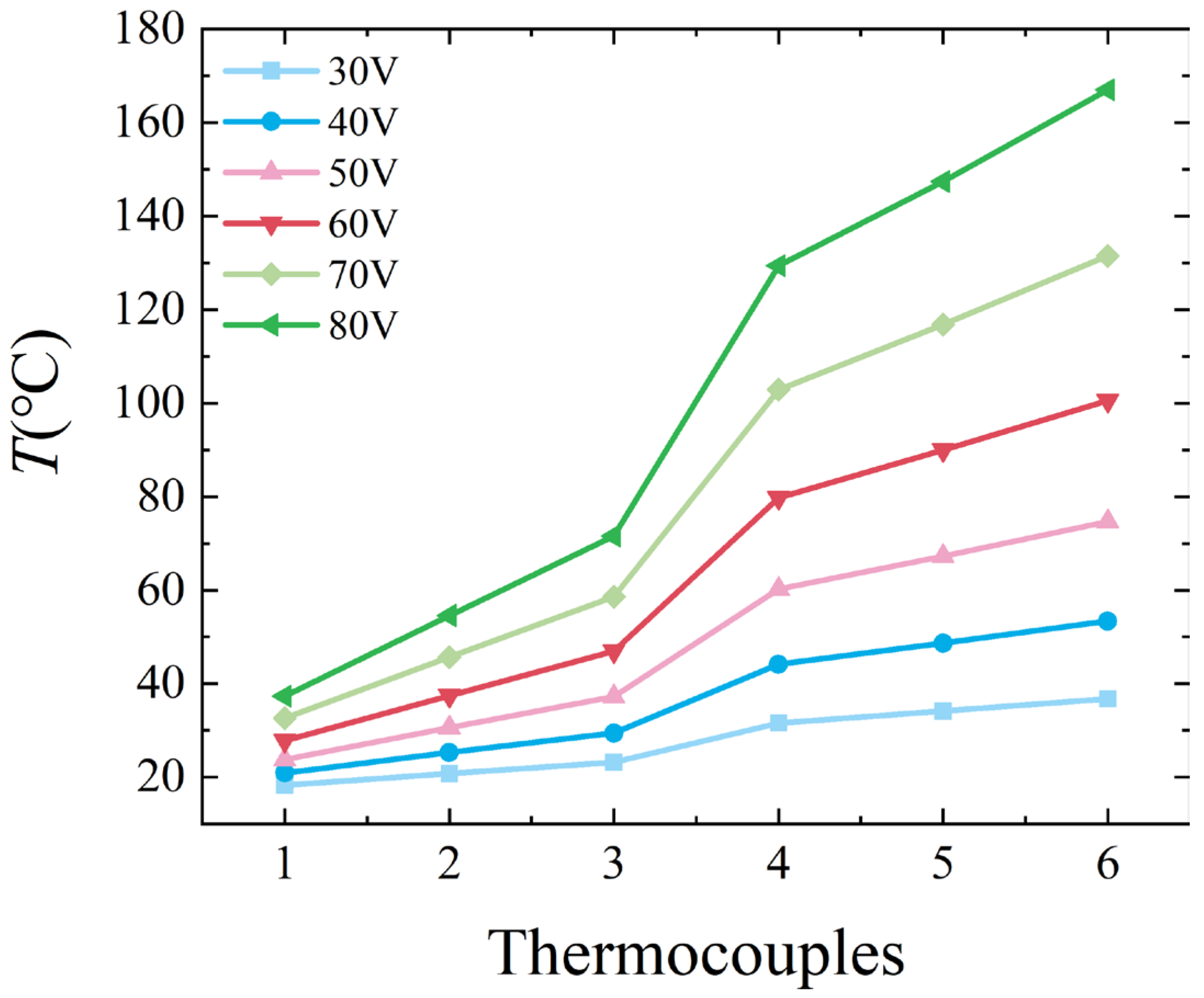



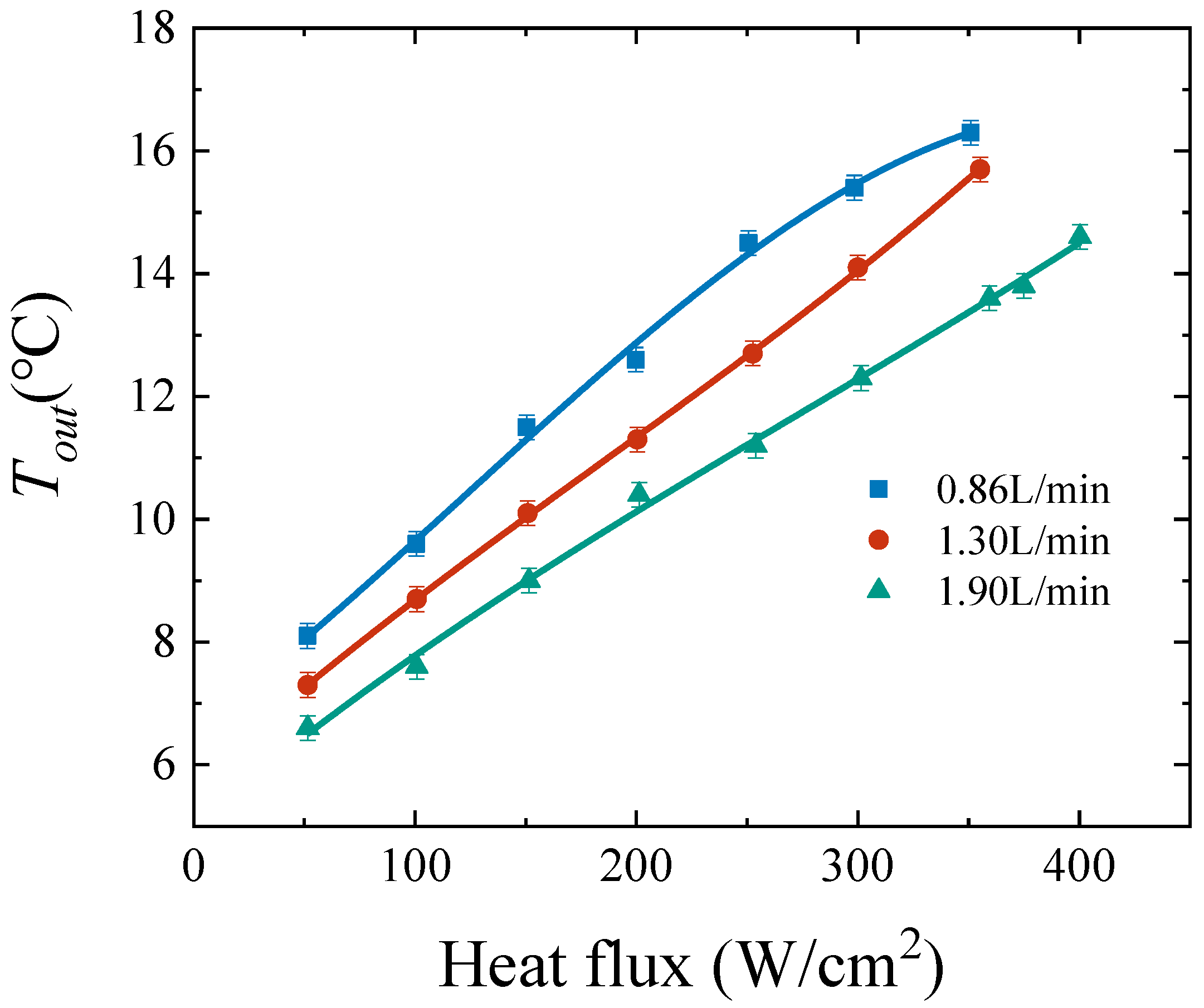
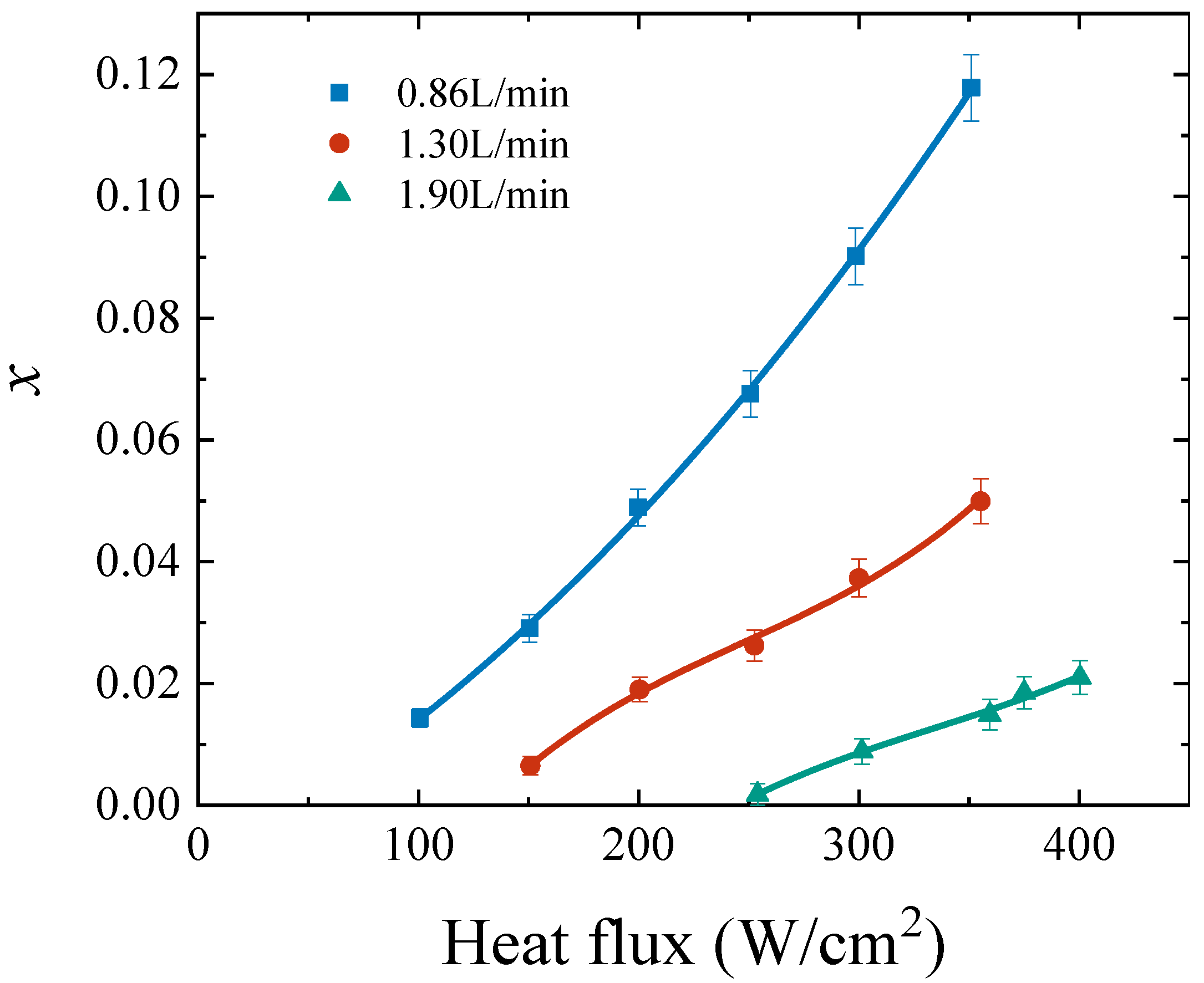
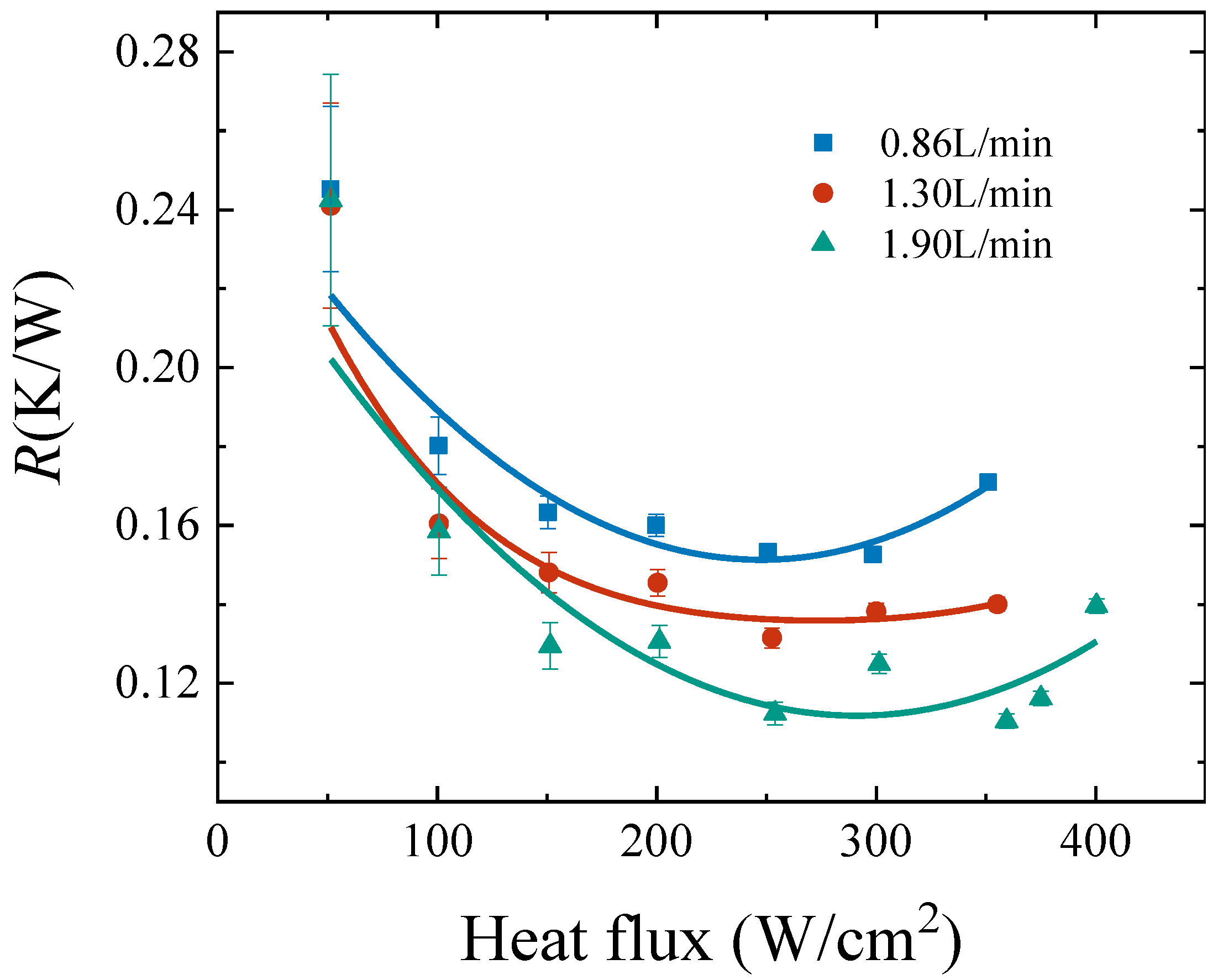

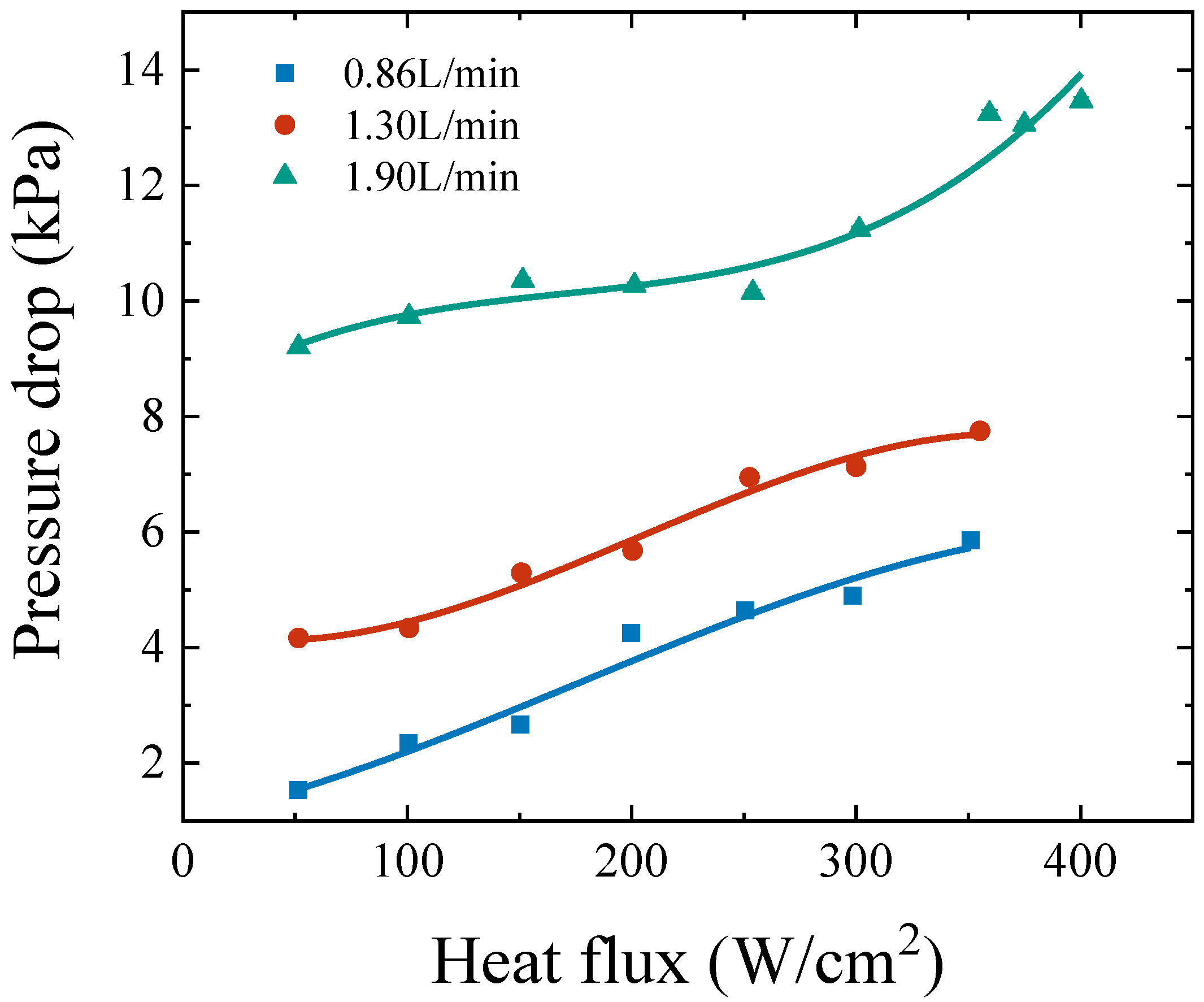
Publisher’s Note: MDPI stays neutral with regard to jurisdictional claims in published maps and institutional affiliations. |
© 2022 by the authors. Licensee MDPI, Basel, Switzerland. This article is an open access article distributed under the terms and conditions of the Creative Commons Attribution (CC BY) license (https://creativecommons.org/licenses/by/4.0/).
Share and Cite
Xiao, R.; Zhang, P.; Chen, L.; Zhang, Y.; Hou, Y. Experimental Study on Cooling Performance of a Hybrid Microchannel and Jet Impingement Heat Sink. Appl. Sci. 2022, 12, 13033. https://doi.org/10.3390/app122413033
Xiao R, Zhang P, Chen L, Zhang Y, Hou Y. Experimental Study on Cooling Performance of a Hybrid Microchannel and Jet Impingement Heat Sink. Applied Sciences. 2022; 12(24):13033. https://doi.org/10.3390/app122413033
Chicago/Turabian StyleXiao, Runfeng, Pingtao Zhang, Liang Chen, Yu Zhang, and Yu Hou. 2022. "Experimental Study on Cooling Performance of a Hybrid Microchannel and Jet Impingement Heat Sink" Applied Sciences 12, no. 24: 13033. https://doi.org/10.3390/app122413033
APA StyleXiao, R., Zhang, P., Chen, L., Zhang, Y., & Hou, Y. (2022). Experimental Study on Cooling Performance of a Hybrid Microchannel and Jet Impingement Heat Sink. Applied Sciences, 12(24), 13033. https://doi.org/10.3390/app122413033







